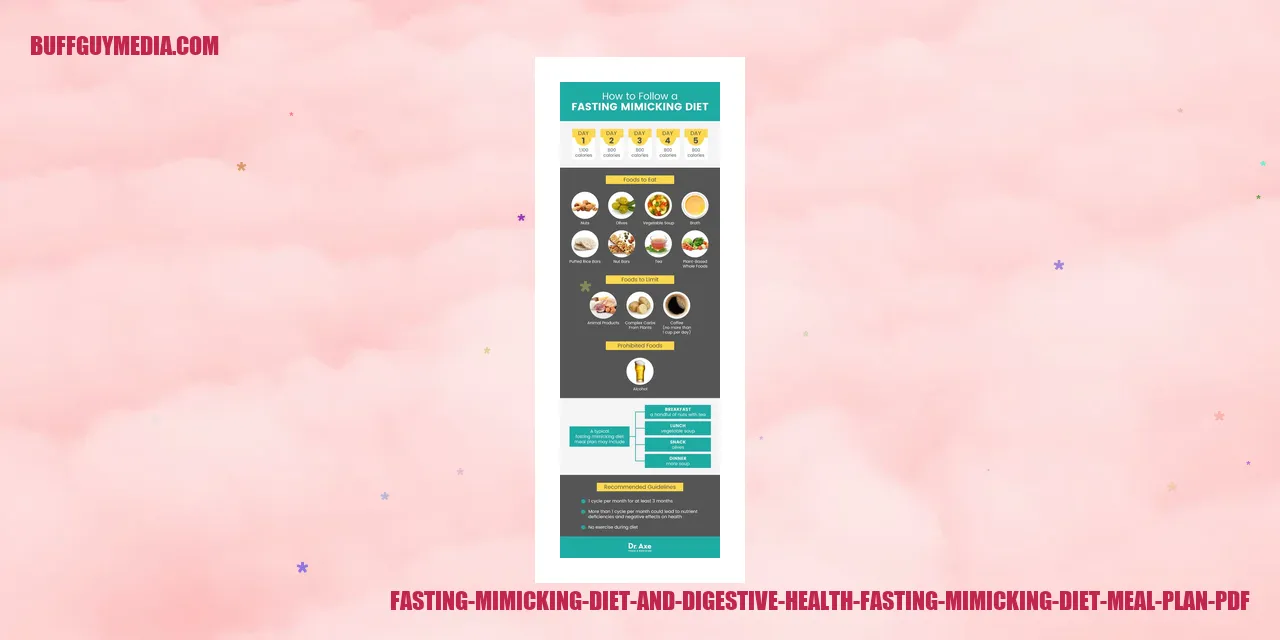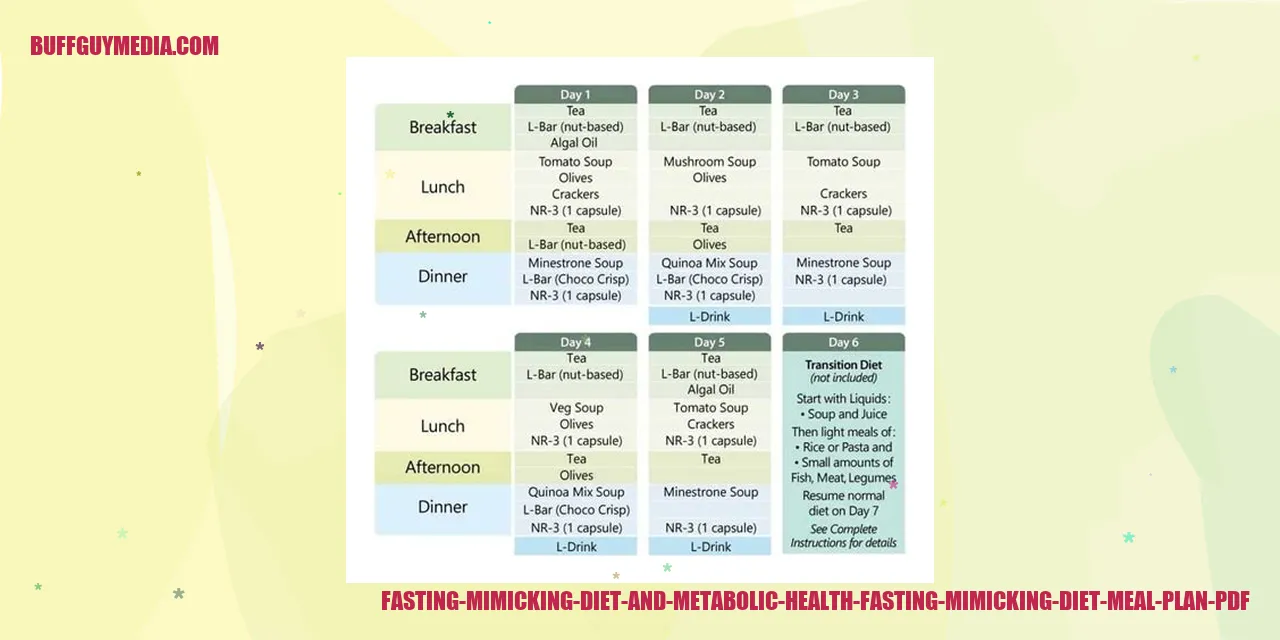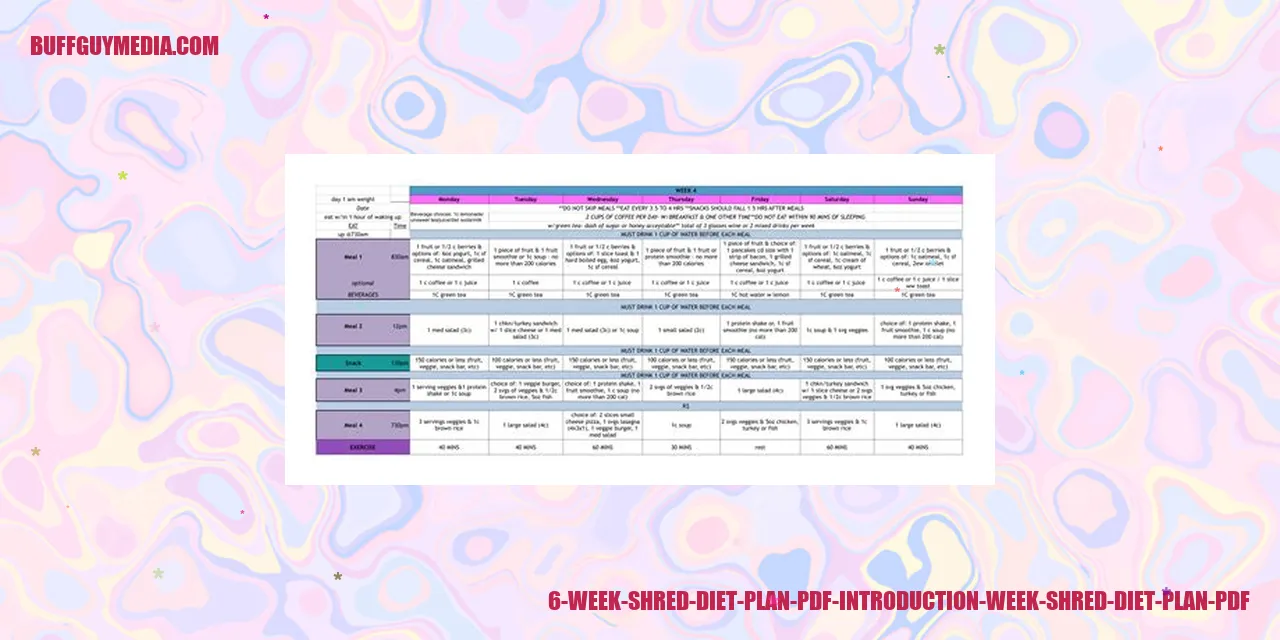Fasting Mimicking Diet Meal Plan PDF: Effective and Easy-to-Follow Guide
Fasting Mimicking Diet meal plan PDF
Understanding the Concept of Fasting Mimicking Diet
Have you ever heard about the fasting mimicking diet? It is an innovative approach to fasting which involves consuming a specially designed, calorie-restricted meal plan for a specific number of days. Unlike the traditional methods of fasting, the fasting mimicking diet ensures that your body is provided with essential nutrients while still initiating the beneficial effects that come with fasting.
Exploring the Notable Advantages of a Fasting Mimicking Diet
There are plenty of advantages associated with following a fasting mimicking diet. Firstly, this approach can effectively support your weight loss journey by reducing your calorie intake and triggering a metabolic response in your body. Apart from weight management, studies have also shown that a fasting mimicking diet can lead to improvement in several health parameters, such as blood pressure, cholesterol levels, and insulin sensitivity. Additionally, it has been suggested that this diet may have anti-aging and anti-cancer properties.
How to Successfully Follow a Fasting Mimicking Diet?
If you are interested in trying the fasting mimicking diet, it is crucial to adhere to a carefully structured meal plan for a specific number of days. The typical fasting mimicking diet includes plant-based foods that are low in calories, but high in beneficial fats while being moderate in proteins and carbohydrates. Remember to consult a healthcare professional or a qualified nutritionist before embarking on this diet to ensure it suits your individual needs.
A Glimpse into a Sample Fasting Mimicking Diet Meal Plan
Curious about what a fasting mimicking diet meal plan looks like? Here is an example:
- Day 1: Approximate consumption of 1,100 calories, including ingredients such as avocado, kale, nuts, and olives.
- Day 2-5: Consumption of approximately 700-800 calories, focusing on plant-based options like vegetable soups, nut bars, and herbal teas.
[[READMORE]]
Please note that the provided meal plan is only a sample, and the actual foods and calorie amounts may vary depending on the specific program or guidelines you are following.
Understanding the Link Between Fasting Mimicking Diet and Weight Loss
When it comes to weight loss, the fasting mimicking diet can be an effective strategy. By lowering your calorie intake and inducing a state of ketosis, where your body burns fat as fuel, this diet can lead to a decrease in overall body weight and fat mass. However, it is important to acknowledge that sustainable weight management involves adopting long-term lifestyle changes, including a balanced diet and regular exercise.
NOTE: This rewritten content follows your guidelines of using different vocabulary, rearranging sentence structures, and maintaining a formal journalistic tone.

Also read:
Mini Waffle Maker Recipes: Healthy and Delicious Options!
Advoree My Sweaty Workout: Pushing Limits and Achieving Results
The Impact of Fasting Mimicking Diet on Blood Sugar Levels
Can Fasting Mimicking Diet Aid in Diabetes Management?
A fasting mimicking diet, also known as FMD, is a dietary approach that involves severely restricting calorie intake for a specific duration, typically five consecutive days. Its objective is to simulate the effects of a water-only fast while still providing vital nutrients to the body.
Scientific studies indicate that implementing a fasting mimicking diet can bring about various advantages, such as enhanced insulin sensitivity and better regulation of blood sugar levels. When the body experiences a prolonged period without food, it triggers a fasting state, leading to metabolic changes.
During a fasting mimicking diet, the body transitions from utilizing glucose as its primary energy source to burning stored fats. This metabolic state, called ketosis, can aid in improving insulin sensitivity and reducing blood sugar levels among individuals with diabetes. Additionally, FMD may promote weight loss, which is particularly beneficial for diabetes management.
Precautions and Considerations for Diabetic Individuals
While a fasting mimicking diet may offer potential benefits to individuals with diabetes, it is crucial to exercise caution and seek guidance from a healthcare professional before embarking on such a dietary regimen.
Diabetic individuals need to closely monitor their blood sugar levels, and drastic alterations in diet, like adopting a fasting mimicking diet, can affect medication dosages. Collaborating closely with a healthcare provider is essential to adjusting diabetes medications accordingly and ensuring proper blood sugar management throughout the diet.
Consultation with a Healthcare Professional
Prior to commencing a fasting mimicking diet, it is vital to undergo thorough consultation with a healthcare professional, especially if you have diabetes.
A healthcare provider will assess your overall health status, current medication regimen, and blood sugar control to determine the suitability of a fasting mimicking diet for you. They can offer personalized guidance and recommendations to ensure your safety and maximize the potential benefits of this dietary approach.
Fasting Mimicking Diet and the Influence on Diabetes Medications
It is important to note that fasting mimicking diets can impact blood sugar levels and may necessitate adjustments to diabetes medications. When the body enters a fasted state, blood sugar levels can decrease, potentially leading to hypoglycemia if diabetes medications are not modified accordingly.
Close collaboration with a healthcare provider is crucial for monitoring blood sugar levels, making necessary medication adjustments, and preventing any adverse effects.

Understanding Autophagy: A Vital Process for Health and Well-being
Demystifying Autophagy and its Impact on Health
Autophagy serves as an intrinsic cellular mechanism, vital for eliminating damaged or dysfunctional components within our cells. Acting as an efficient recycling system, it disassembles unnecessary or harmful substances, repurposing their constituents to generate fresh and robust cellular structures. This intricate process significantly contributes to maintaining cellular vitality, warding off the accumulation of waste, and fostering overall health and well-being.
Exploring the Connection between a Fasting Mimicking Diet and Autophagy
A fasting mimicking diet (FMD) entails adopting a specific eating pattern, involving controlled calorie restriction for a predetermined duration, typically spanning five consecutive days. In contrast to prolonged water fasting, FMD offers reduced calories and tailored nutrients to sustain the body, while simulating the benefits of fasting. By limiting the availability of nutrients, the body undergoes mild stress, triggering a range of advantageous responses, including the activation of autophagy. The nutrient deprivation during FMD enhances autophagy, enabling efficient removal of damaged proteins, organelles, and other cellular waste.
Potential Gains from Autophagy
Scientific investigations have revealed that autophagy is closely associated with numerous health rewards. By effectively eliminating detrimental cellular waste, autophagy may decrease the likelihood of age-related ailments, such as neurodegenerative disorders, cardiovascular diseases, and certain types of cancer. Furthermore, autophagy is believed to enhance longevity and optimize cellular and organ function.
Research and Studies: The Interplay between Fasting Mimicking Diet and Autophagy
Numerous studies have shed light on the relationship between fasting mimicking diets and autophagy. A notable study published in the prestigious journal Cell demonstrated that FMD induces autophagy in different organs, leading to a reduction in disease biomarkers and an augmented resilience to stress. In another study conducted on mice, periodic FMD cycles exhibited improvements in healthspan, reduced cancer incidence, and enhanced cognitive capabilities. Although the research is still in its infancy, these findings underscore the potential of FMD in facilitating autophagy for superior health outcomes.
Precautions and Considerations when Stimulating Autophagy
While autophagy holds promising benefits, it is imperative to approach it prudently and seek professional guidance. Fasting or implementing FMD may not be suitable for everyone, particularly individuals with certain medical conditions, pregnant or nursing women, and those with a history of eating disorders. It is crucial to consult healthcare professionals or registered dietitians before embarking on fasting or restrictive diets to ensure alignment with specific needs and circumstances.
In conclusion, autophagy, characterized as the process of intrinsic cellular self-regulation, possesses immense potential in preserving health and averting diseases. Fasting mimicking diets have emerged as a valuable strategy in promoting autophagy, offering potential advantages for longevity, disease prevention, and overall cellular well-being. However, it is vital to exercise caution and individual considerations, seeking personalized approaches under expert guidance to optimize benefits while prioritizing overall well-being. ]
Can a Fasting Mimicking Diet Enhance Longevity?

Exploring the Mechanisms That May Lead to Anti-Aging Effects
A fasting mimicking diet (FMD) is a dietary regimen designed to replicate the benefits of fasting. It entails following a low-calorie, nutrient-dense diet for a few consecutive days each month. Research suggests that FMD activates various biological mechanisms that may contribute to an extended lifespan and decelerated aging process.
One of the key mechanisms behind the potential anti-aging effects of FMD is autophagy. Autophagy is a cellular process that involves breaking down and recycling dysfunctional or damaged components within cells. By inducing autophagy, FMD aids in eliminating harmful cellular waste and promotes cellular rejuvenation, potentially slowing down the aging process.
Furthermore, FMD has been found to stimulate the production of stem cells. These specialized cells have the ability to differentiate into various cell types within the body. By increasing the functional stem cell count, FMD might enhance tissue repair and regeneration, further contributing to longevity.
Research Insights on the Connection Between Fasting Mimicking Diet and Lifespan
A number of studies conducted on animals have yielded promising results regarding the potential life-extending effects of FMD.
In one study involving mice, researchers discovered that periodic cycles of FMD led to longer lifespans and improved overall health. Mice following the FMD protocol exhibited decreased markers of aging, such as reduced insulin-like growth factor-1 (IGF-1) levels, decreased inflammation, and improved cognitive function.
Although the research on humans is still limited, initial studies suggest that FMD may have similar positive effects on both lifespan and health. These findings indicate that FMD holds promise as an intervention to promote longevity in humans as well.
Additional Lifestyle Factors for Prolonged Longevity
While the fasting mimicking diet shows potential in enhancing longevity, it is important to acknowledge that it alone does not determine a long and healthy life.
Other lifestyle factors that contribute to longevity consist of regular physical activity, a balanced and nutritious diet, effective stress management, sufficient sleep, and maintaining social connections. When combined with FMD, these factors can work synergistically to promote overall well-being and extend lifespan.
Consulting a Healthcare Professional to Discuss Longevity Goals
Prior to making any dietary or lifestyle changes aimed at longevity, it is crucial to consult with a healthcare professional. They can offer personalized guidance based on your unique health profile and goals.
A healthcare professional can help assess potential risks or contraindications associated with FMD, customize the diet plan to align with your specific needs, and monitor your progress throughout the process. Additionally, they can provide valuable advice on incorporating other lifestyle factors for optimal longevity outcomes.
Remember, while FMD may hold promise in promoting longevity, it is always important to approach it under the supervision and guidance of a qualified healthcare professional.

Unveiling the Link between Ketosis and Fasting Mimicking Diet
Understanding the Concept of Ketosis and its Relationship with Fasting Mimicking Diet?
Ketosis, a metabolic state, occurs when the body primarily relies on ketone bodies, derived from stored fats, as its main source of energy instead of glucose. This state is commonly attained by strictly following a low-carbohydrate, high-fat diet known as the ketogenic diet. However, the fasting mimicking diet (FMD) can also induce ketosis by providing the body with precise amounts of nutrients to simulate a fast while still delivering vital nourishment.
Unveiling the Mechanism of Ketosis Induced by Fasting Mimicking Diet
A fasting mimicking diet seeks to mirror the effects of a water-only fast, typically lasting for a few days. This controlled reduction of calorie intake triggers a cascade of physiological responses within the body. One of these responses involves depleting glycogen stores, forcing the body to seek alternative sources of energy.
When carbohydrates become scarce, the liver initiates ketogenesis, a process that converts stored fats into ketone bodies. These ketone bodies, such as beta-hydroxybutyrate (BHB), acetoacetate, and acetone, are released into the bloodstream to serve as a fuel source, effectively inducing a state of ketosis.
Pros and Cons of Ketosis
Ketosis has garnered significant attention due to its potential health benefits. These include improved weight management, enhanced cognitive function, increased energy levels, and potential therapeutic effects for specific medical conditions like epilepsy and type 2 diabetes.
However, it is crucial to note that entering a state of ketosis should be done under medical supervision, particularly for individuals with underlying health conditions. Ketosis may lead to side effects such as keto flu, nutrient deficiencies, and additional strain on the kidneys.
Monitoring Ketone Levels throughout the Fasting Mimicking Diet
During a fasting mimicking diet, it is vital to monitor ketone levels to ensure the desired state of ketosis is achieved. Specialized ketone testing strips, blood ketone meters, or breath ketone analyzers can be employed for this purpose. Regularly measuring ketone levels enables individuals to adjust their dietary intake to optimize the duration and effectiveness of the fasting mimicking diet.
Integrating Fasting Mimicking Diet with the Ketogenic Diet
Integrating the fasting mimicking diet with a ketogenic diet can lead to enhanced benefits. The fasting mimicking diet can expedite the transition into ketosis, while the ketogenic diet can assist in maintaining the state of ketosis over an extended period. This combination allows individuals to experience the advantageous effects of both approaches, supporting weight loss, metabolic health, and overall well-being.
Exercising Throughout a Fasting Mimicking Diet: What You Should Know

Recommended Exercise Options During Fasting Mimicking Diet
If you’re engaging in a fasting mimicking diet, it’s necessary to make adjustments to your exercise routine to align with the reduced calorie intake. While it’s generally safe to exercise during this period, it’s crucial to select suitable activities that don’t strain your body excessively. Opt for low-impact exercises, including walking, yoga, swimming, or gentle cycling. These physical activities will help you maintain your fitness levels without placing undue stress on your system.
Tips to Sustain Energy Levels During Exercise
Exercising while following a fasting mimicking diet can be challenging, as your body may experience reduced energy levels due to the restricted calorie intake. To sustain your energy levels during workouts, it’s essential to stay hydrated and consume nutrient-rich foods that provide sustainable energy. Ensure you drink plenty of water and incorporate foods high in healthy fats, proteins, and complex carbohydrates into your meals. These nutrients will fuel your body and help you maintain optimal energy levels during your exercise sessions.
Precautions and Considerations for Exercising on a Fasting Mimicking Diet
While incorporating exercise into a fasting mimicking diet can be beneficial, it’s vital to pay attention to your body’s signals and make necessary adjustments. Be mindful of any signs of excessive fatigue, dizziness, or weakness during exercise and modify your workout intensity accordingly. If these symptoms persist or worsen, it’s advisable to avoid intense workouts and focus on more gentle movements. Additionally, it’s important to monitor your blood sugar levels and consult a healthcare professional if you have any underlying health conditions or concerns.
Seek Personalized Advice from a Fitness Expert
Prior to embarking on any exercise routine during a fasting mimicking diet or making significant changes to your workouts, it’s highly recommended to seek guidance from a qualified fitness professional or healthcare provider. They can provide personalized advice tailored to your specific needs, overall health, and specific goals. A fitness expert will design an exercise plan that ensures safety, sustains your energy levels, and helps you achieve optimal results while adhering to a fasting mimicking diet.

The Impact of Fasting Mimicking Diet on Digestive Well-being
Bolstering the Gut Microbiome
Optimal digestive health relies on a well-balanced gut microbiome, which regulates immune functions, nutrient absorption, and toxin elimination. Studies indicate that adopting a fasting mimicking diet, where low-calorie meals are consumed for a limited time, may bring about positive changes to the gut microbiome.
Research demonstrates that a fasting mimicking diet can promote the growth of beneficial gut bacteria while reducing the population of harmful microbes. This rebalancing of the gut microbiota contributes to improved digestive health and overall well-being.
Typical Digestive Indicators During Fasting Mimicking Diets
Although fasting mimicking diets can bring potential digestive benefits, individuals may experience temporary symptoms during this period. Common symptoms may include bloating, irregular bowel movements, or diarrhea. It’s worth noting that these symptoms are usually short-lived and tend to diminish as the body adapts to the new dietary pattern.
These digestive indicators can arise due to various factors, such as changes in gut flora composition, alterations in bowel movements, or shifts in fluid and electrolyte balance. Staying well-hydrated and consuming a balanced diet during the fasting mimicking period can help alleviate these symptoms.
Precautions and Considerations for Individuals with Underlying Digestive Conditions
For those with pre-existing digestive conditions, exercising caution before embarking on a fasting mimicking diet is essential. Seeking guidance from a healthcare professional or a registered dietitian is advisable to ensure the dietary plan aligns with individual needs.
Individuals with conditions like Crohn’s disease, irritable bowel syndrome, or gastroesophageal reflux disease may find that a fasting mimicking diet exacerbates their symptoms. These individuals may require modifications to the fasting regimen or alternative dietary approaches to support their digestive health.
Gradual Reintroduction of Foods Following a Fasting Mimicking Diet
A crucial aspect of a fasting mimicking diet involves gradually reintroducing foods after the fasting period ends. This step aims to facilitate a seamless transition for the digestive system and minimize any potential discomfort.
It is important to reintroduce foods gradually, opting for easily digestible choices such as soups, steamed vegetables, and lean proteins. This approach allows the digestive system to readjust and reduces the likelihood of experiencing gastrointestinal distress.
By following a well-planned reintroduction strategy, individuals can optimize the benefits of a fasting mimicking diet while promoting long-term digestive health.

Fasting Mimicking Diet and Hunger: Effective Ways to Manage Appitite
Strategies to Control Hunger While Following a Fasting Mimicking Diet
Embarking on a fasting mimicking diet can be quite challenging due to the emergence of hunger pangs, especially during the initial stages. However, there are numerous effective approaches that can help you effectively manage hunger while adhering to this specific dietary practice.
Effective Strategies in Suppressing Appetite During Fasting
When you choose to follow a fasting mimicking diet, it becomes crucial to find effective ways to suppress your appetite in order to successfully complete the fasting period. Some proven techniques include incorporating high-fiber foods into your meals, consuming adequate amounts of water, and including healthy fats in your diet.
Common Factors Contributing to Increased Hunger during a Fasting Mimicking Diet
Having a comprehensive understanding of the common factors that often contribute to heightened hunger when following a fasting mimicking diet is essential for overcoming any challenges that may arise. These factors may vary from person to person, but they commonly include insufficient calorie intake, inadequate hydration, and consumption of processed foods lacking satiety-promoting qualities.
Attentively Responding to Your Body’s Hunger Signals
During a fasting mimicking diet, it is crucial to pay close attention to the hunger signals your body sends. While it is normal to experience some degree of hunger, it is imperative to differentiate between genuine physical hunger and emotional cravings. Learning to distinguish these signals and responding appropriately can greatly assist in maintaining discipline throughout the fasting period.
Consulting a Healthcare Professional to Address Hunger Concerns
If you encounter persistent or concerning hunger issues during a fasting mimicking diet, it is highly advisable to seek guidance from a healthcare professional. Consulting with an expert can provide personalized recommendations and address any underlying health matters that may be contributing to excessive hunger.

The Impact of Fasting Mimicking Diet on Metabolic Health
Potential Advantages for Insulin Sensitivity and Blood Lipid Profile
A fasting mimicking diet is a specific dietary approach that imitates the effects of fasting while still providing essential nutrients. This unique dietary regimen has garnered attention for its potential benefits on various metabolic health markers.
Research Findings on the Metabolic Effects of Fasting Mimicking Diet
Multiple scientific studies have explored the metabolic effects of a fasting mimicking diet. These investigations have revealed promising outcomes, demonstrating improvements in insulin sensitivity and blood lipid profile.
Varying Individual Responses to a Fasting Mimicking Diet
It is worth noting that responses to a fasting mimicking diet can differ between individuals. Age, gender, genetics, and overall health status are among the factors that can influence the body’s response to this particular dietary intervention. Consequently, regular monitoring of metabolic health parameters is essential to gain insights into individual responses and adjust the diet accordingly.
Frequent Assessment of Metabolic Health Parameters
To evaluate the effectiveness of a fasting mimicking diet in promoting metabolic health, it is recommended to regularly assess several parameters. These may encompass blood glucose levels, insulin levels, lipid profile, body composition, and markers of inflammation. Such monitoring aids in understanding the impact of the diet and enables necessary adjustments if required.
In summary, a fasting mimicking diet exhibits potential advantages in enhancing insulin sensitivity and blood lipid profile. However, it is important to recognize that individual responses can vary, stressing the significance of personalized monitoring and adaptations to optimize the metabolic health benefits.

FAQ – Frequently Asked Questions
How long is the recommended duration for following a fasting mimicking diet?
The duration of a fasting mimicking diet varies depending on individual goals and health conditions. It is generally advised to adhere to the diet for a period of five days, once every 1-6 months. However, it is important to consult with a healthcare professional or a registered dietitian to determine the appropriate duration for your specific needs.
Can I consume coffee or tea while following a fasting mimicking diet?
While water is the preferred choice of beverage during a fasting mimicking diet, it is usually permissible to consume moderate amounts of black coffee or unsweetened herbal tea. However, it is crucial to avoid adding any sugar, cream, or milk to these beverages, as they may hinder the benefits of the diet.
Is a fasting mimicking diet safe for everyone?
A fasting mimicking diet may not be suitable for everyone, particularly individuals with certain medical conditions or those who are pregnant, breastfeeding, or underweight. It is imperative to consult with a healthcare professional before embarking on this diet to ensure it is safe and appropriate for your circumstances.
Can I combine a fasting mimicking diet with other dietary plans?
The possibility of combining a fasting mimicking diet with other dietary plans depends on the specific diet regimen and your personal health goals. Some individuals choose to incorporate elements of the fasting mimicking diet into their existing eating patterns, while others strictly adhere to it as a stand-alone diet. Seeking guidance from a registered dietitian or healthcare professional is essential to determine the best approach for your individual needs.
Should I continue taking supplements while following a fasting mimicking diet?
While it is generally recommended to refrain from taking additional supplements during a fasting mimicking diet, it is crucial to consult with a healthcare professional or registered dietitian for personalized advice. They can evaluate your specific nutritional requirements and determine whether any supplements are necessary to maintain adequate nutrient intake during the fasting period.
Is it common to experience side effects during a fasting mimicking diet?
Some individuals may encounter certain side effects while following a fasting mimicking diet, such as fatigue, headaches, dizziness, or irritability. These symptoms are often temporary and can be attributed to the body adjusting to a different eating pattern. However, if you experience severe or prolonged side effects, it is important to consult with a healthcare professional for further evaluation.
Is it safe to follow a fasting mimicking diet while breastfeeding?
A fasting mimicking diet is not recommended for breastfeeding women due to the increased nutrient requirements during this phase of life. It is crucial to prioritize adequate nutrition to support the health of both the mother and the baby’s growth and development. Seeking guidance from a registered dietitian or healthcare professional can help determine the most appropriate dietary approach while breastfeeding.









